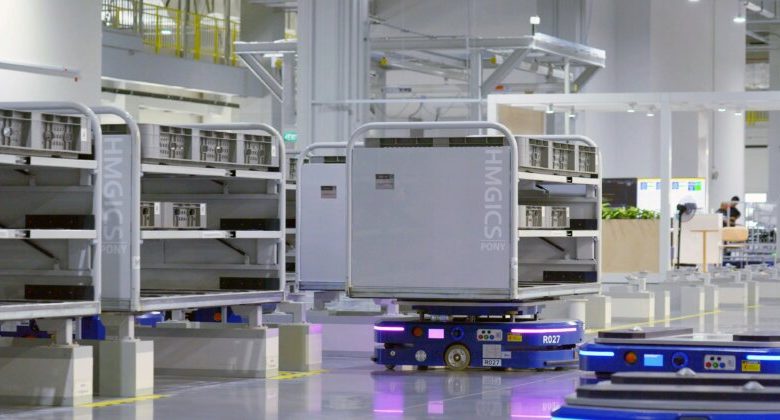What Are AMRs and How Do They Revolutionize Modern Warehousing?

Warehouses are the backstage crew of modern retail — absolutely crucial but not given nearly
enough credit. And if we’re honest, the idea of a warehouse doesn’t exactly scream “cutting edge.”
We imagine rows of boxes, tired forklifts, and people manually moving things around clipboard in
hand. But there’s an up-and-coming player in the game that’s turning the old-school idea of
warehousing on its head — autonomous mobile robots, or AMRs for short.
These little guys are efficient, precise, and — you guessed it — autonomous. They are transforming
how businesses manage inventory, process orders, and generally keep the world’s goods flowing.
Today, we’re diving into how these robots revolutionize the modern warehouse.
So, What Are AMRs?
You can think of an AMR as a Roomba on steroids. Except, instead of just vacuuming up your dust
bunnies, it does some seriously complicated stuff.
AMRs are robots that don’t just do what you tell them; they figure out how to get the job done all by
themselves. They don’t need a human to control them, and they don’t follow a fixed path like those
traditional conveyor belts or AGVs (automated guided vehicles) of yesteryear.
These bad boys use sensors, cameras, and fancy algorithms to make decisions on the fly. If a box is in
their way, they’ll go around it. If they need to head to a different part of the warehouse, they’ll map
the most efficient route and just take off.
They use similar tech to self-driving cars, like LIDAR (that’s “light detection and ranging” in case you
want to be extra fun at parties), to understand their surroundings and navigate safely. No crashes,
no drama — just pure efficiency.
How Do They Work?
As explained above, AMRs don’t need a dedicated driver like a forklift does. Instead, they’re fitted
with a ton of sensors and real-time data processing tools, so they can react to their surroundings as
they move around.
Like toddlers, they’re constantly learning and adapting to the environment, but unlike toddlers,
they’re not bumping into everything in their path in the process.
That means the warehouse layout can be more flexible, and AMRs can switch up their routes if
things get too crowded. Instead of following some pre-determined path, they’re actively thinking
about where to go and what to do.
Okay, But Why Are They Such a Big Deal?
Alright, so why does this matter? Why should anyone care? It’s pretty simple, actually: warehouses
are the backbone of so many industries.
Whether it’s e-commerce, manufacturing, or even grocery stores — almost everything you buy has
spent some time hanging out in a warehouse. And with the rise of online shopping (thanks,
Amazon!), warehouses are under pressure to be faster and more efficient than ever before.
AMRs don’t need breaks, coffee, or sick days. They can work 24/7, picking up and delivering goods
all over the warehouse. And since they can navigate dynamically, they don’t cause traffic jams or
bottlenecks, which, let’s be real, humans have shown a proclivity for.
This means orders get processed faster, inventory gets moved quicker, and companies save a bunch
of money on labor costs. Plus, they’re more accurate than humans when it comes to picking and
packing items, so you can kiss those frustrating order mix-ups goodbye.
AMRs vs. AGVs: Robot Wars
You might be thinking, “Hold up, haven’t warehouses been using robots for years now?” Yep, they
sure have. However, AGVs, or automated guided vehicles, are the older, less cool version. They
follow pre-set paths, usually guided by magnetic strips or wires embedded in the floor.
Sure, they’re better than humans pushing carts around, but they’re not exactly next-gen tech. AGVs
can’t adapt on the fly or change their routes when something unexpected happens. AMRs, on the
other hand, are like, “Nah, I’ve got this,” and find another way to get where they’re going.
So, in the battle of AGVs vs. AMRs, the latter wins every time. AMRs are just smarter, faster, and
more flexible.
How AMRs Are Changing the Game in Warehousing
First off, AMRs allow for more flexible warehouse layouts. Since they don’t need fixed paths, you can
rearrange your warehouse any way you like, and the AMR will just figure it out. No need to rip up
the floor and lay down guidance tracks either.
Secondly, they play nice with other technologies. If your warehouse already has something like an
automated storage and retrieval system (AS/RS) or a conveyor belt, AMRs can integrate smoothly.
And since they’re autonomous, you don’t need to hire a bunch of new people to manage them —
just a few tech-savvy operators to keep an eye on things.
The Future of Warehousing With AMRs
The way things are going, we’ll see more and more robots like AMRs popping up in warehouses all
over the world. Some experts think that, eventually, we could have fully automated warehouses
where humans only step in for maintenance or troubleshooting. And while that might sound a bit
sci-fi, it’s not as far off as you might think.
In the meantime, AMRs are helping businesses become more efficient, reducing operating costs, and
speeding up the time it takes to get products from point A to point B. As more companies ask
themselves, “What are AMRs and how can they be used?” we’ll likely see them take over warehouse
operations.
The future is here — and it’s got a ton of sensors.




